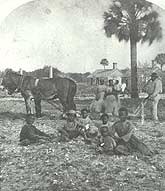
Slave labor on this Sea Island cotton plantation was performed according to the “task system.” Under this system, each slave was assigned a specified amount of work for the day and upon completion of this task, the slave was permitted to use the balance of the day as he or she chose. Tasks in the fields were measured by units of a quarter of an acre (105 ft. square). Tasking requirements outside the field were often defined as well. Ginning 20-30 lbs. of cotton was a daily task. A barrel maker’s (cooper’s) task might be set at constructing three barrels a day. Under the task system, it was assumed that slaves would raise a variety of crops in their own gardens. These products could supplement the slaves’ plantation rations, or be traded or sold through the plantation owner. While the task system was distinctive to the rice and Sea Island cotton plantations of the southeastern coastal region, the “gang system” was prevalent on plantations in Virginia and throughout the middles and western South. Under the gang system, slaves were worked in groups under the supervision of a driver (also a slave) and compelled to work the entire day for the owner's profit. Crop requirements were important in determining what labor system was practiced. The highly regimented and supervised gang system was practiced on sugar and tobacco plantations. Proceed to Family Life. Return to Slave Community. |
Last updated: April 14, 2015
